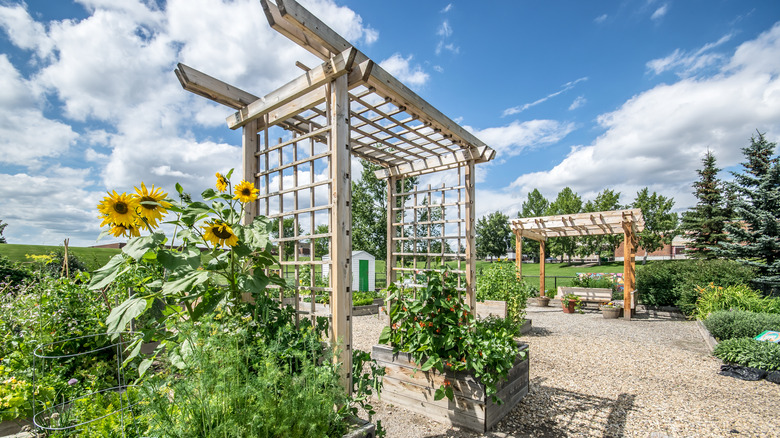The Fast-Growing Purple Bean Vine That Looks Stunning On A Garden Trellis
Whether you're sitting under it with a good book or framing your front door as a leafy welcome to visitors, a plant-laden trellis can be an oasis that maximizes your outdoor space. Create that oasis more quickly with a purple bean vine that grows at a sprinter's pace. If you need to pretty up your garden quickly, prolific hyacinth beans (scientific name lablab purpureus) are a top candidate.
Also known as vaal bean, these stunning vines are fast-growing, beautifully varied, and even edible. Native to Africa and Asia, these plants can grow up to 20 feet in one season. Purple hyacinth bean vines spilling over a trellis will bring more pollinators into your yard and garden. With its pleasing purple flowers, 3- to 5-inch-long beans, purplish-green or even bronze leaves, and incredible vigor, the hyacinth bean is a marvel of nature. While it climbs trellises with ease, purple hyacinth beans can also spread into a lovely ground cover. Some popular varieties of this vine are purple moon, ruby moon, and red-leaved, and all of them share the qualities that make them ideal for a trellis. You're likely to love this plant as much as Thomas Jefferson did in his Monticello garden.
Growing hyacinth beans on a trellis is easier than you think
Drought-resistant hyacinth beans have tropical origins, so naturally this plant will grow best in hotter, humid regions. While hyacinth bean vines are annual plants, they can be grown as perennials in warmer climates, typically in USDA zones 10-11 but you may have some luck in zone 9 provided you have no frost. Although purple hyacinth beans prefer a hot climate, this graceful vine can grow as an annual in many zones and even thrive on your patio – if you're on the fence about this, check out the benefits of a container garden.
To plant this beautiful vine in your garden, your trellis should be in full sun or part shade. Hyacinth beans grow best in well-drained soil that is sandy or clay. Growers recommend speeding up germination by soaking them in water overnight before sowing — some recommend making a small slice in the seed's surface first. Gardeners in colder regions suggest sowing seeds indoors to give plants a head-start. Once the chance of frost has passed and temperatures are above 65 degrees Fahrenheit, plant the seeds between ½ and 1 inch deep, about 12 inches apart.
As the vines grow, protect them from hungry deer who love to nibble hyacinth bean shoots. Also make sure that your trellis is sturdy and secured well enough to support up to 25 feet of vine. The vine will naturally climb up the trellis. Once your plant is established, it needs little maintenance other than regular watering.

